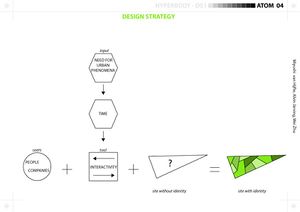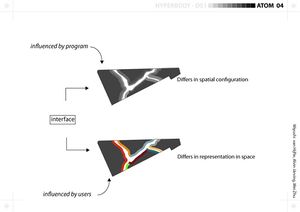project E:Home
(→INTERVENTION) |
(→Process strategy) |
||
| Line 34: | Line 34: | ||
Our Project is about the gradience between the private and public. The design effort lies in the transition space between the streetscape and the buildings. This concept creates the contrast between flexible buildings and the identity holding interface landscape. | Our Project is about the gradience between the private and public. The design effort lies in the transition space between the streetscape and the buildings. This concept creates the contrast between flexible buildings and the identity holding interface landscape. | ||
| − | == | + | ==Project components== |
| − | The | + | |
| + | The interface between the public and private is created through spatial needs according to the client profiles ('''transition landscape'''). The interface embodies the representational means ('''the memory machine''') to achieve the identity. | ||
| + | |||
==Memory Machine== | ==Memory Machine== | ||
The memory machine is a tactical tool to improve the site identity. It replay 'translated' moments according to the needed mood at every moment. | The memory machine is a tactical tool to improve the site identity. It replay 'translated' moments according to the needed mood at every moment. | ||
Revision as of 14:10, 12 October 2011
Contents |
CONCEPTION
Challenge
Our design challenge is to create a site with evolving identity which serves the spatial affordance of certain activities in dynamically changing programmatic context.
Specialization
Site conditioning for identity. The site has to be conditioned to have a set of qualities that allow fixed character through desired activities. We are achieving these qualities through representational and spatial means. Our challenge is to manipulate the with the memory of the users to amplify activities.
INTERVENTION
Our Project is about the gradience between the private and public. The design effort lies in the transition space between the streetscape and the buildings. This concept creates the contrast between flexible buildings and the identity holding interface landscape.
Project components
The interface between the public and private is created through spatial needs according to the client profiles (transition landscape). The interface embodies the representational means (the memory machine) to achieve the identity.
Memory Machine
The memory machine is a tactical tool to improve the site identity. It replay 'translated' moments according to the needed mood at every moment. The replayed moments are collected date from the users who are using the site. the translation is done by a kind of filter what translate the monents into sounds and visuals. The replaying of is a representation in space what will create a different 'mood'. Thereby the representation is related/adjunct to time. The time of replay will influences the experiences of the users. This is controlled by the occupation of the site.
Transition Landscape
The Border between the private and the public gives us a clear research theme on existing typologies. The becoming from private to public can (the levels and the sizes of the transition spaces) can be seen as parameters for the spatial affordance of desired program. The parametric model will be dealing with the measure of the void in terms of the porocity, transparency and permeability.
Typology
We studied different commercial typologies and measured their levels between the public and private space.

